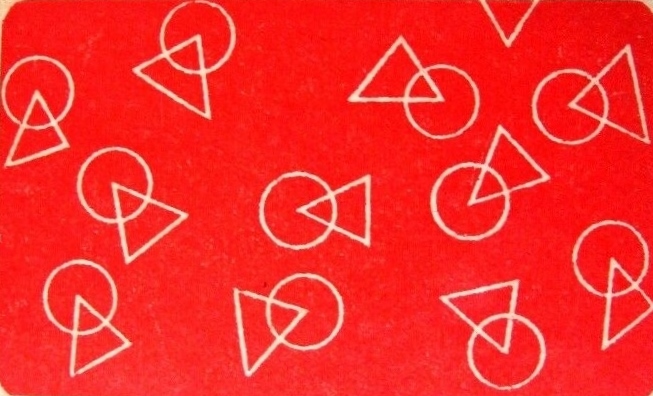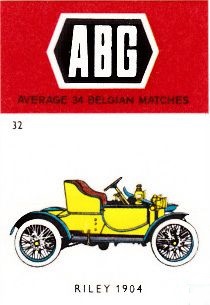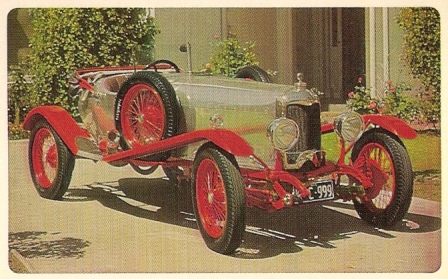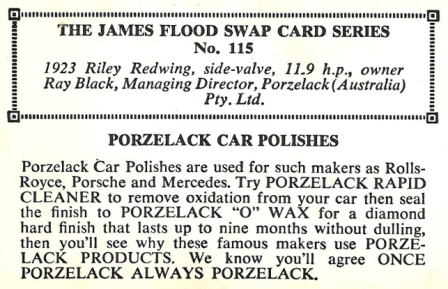|
RILEY CAR COLLECTORS CARDS
Strictly speaking not all collectors cards, some are calendars, matchboxes etc from collectors sets.
Collectors cards, printed in Italy, 9 Rileys shown below.
Front text :- 1926 - 1937 Riley Nine Monaco
Summary rear text :- The 1934 Monaco saloon had a steel-panelled body.
Only the sunshine roof was fabric. It cost £220.
Front text :- 1928 - 1932 Riley Nine Brooklands
Summary Rear text :- Occupants of a Brooklands could reach out and touch
the road surface. Cycle wings, lights and a conventional screen were often fitted.
Front text :- 1933 - 1935 Riley Imp
Summary rear text :- Low slung and well proportioned, the Imp looked faster than it
was. In general layout it was typical of a successful generation of British sports cars.
Front text :- 1934 - 1936 Riley MPH
Front text :- 1934 - 1937 Riley Sprite
Front text :- 1934 - 1938 Riley Kestrel
Front text :- 1935 - 1938 Riley 15/6
Summary rear text :- An immaculate Lynx tourer. Folded hood projected over the external
spare wheel at the back and there is a tonneau cover over the rear seats.
Front text :- 1946 - 1954 Riley RM 1 1/2 litre
Summary rear text :- All RM's had a traditional grille and headlights protruding
from valances between wings and bonnet. This RME has running boards and rear wheels partially enclosed.
Front text :- 1961 - 1969 Riley Elf
Summary rear text :- Concealed door hinges, push-button door
handles and windows identify this car as a MKIII Elf. Extended boot added 10in (26cm) to overall length.
British Cars of the 50's & 60's
No.8 in a series
On the back it says :-
Riley RME 1 1/2-LITRE (1953) The last "true" Riley, the RM sports saloons
dated from 1946, when the 1 1/2 litre RMA and 2 1/2 litre RMB appeared.
Traditional features included a wooden-framed, steel skinned
body shell on seperate chassis, fabric roof covering and walnut dash.
The RME 1 1/2 litre/RMF 2 1/2 litre cars of 1952 featured improved
chassis and brakes: the RME's graceful front wings were cut back and running boards
deleted; it ceased production in 1955.
"British Cars of the 50's & 60's"
No.34 in a series
On the back it says :-
"RILEY ELF II (1963) In 1961, BMC added a "bustle" boot and Riley grill to the Mini's
engine and chassis. The Wolsley Hornet, introduced simultaneously, was almost
identical. Inside the Riley were up-market trim and a walnut dash. The new 998cc
A-Series engine powered the MkII, built 1963-66, and Hydrolastic suspension
later replaced the original rubber cones. Cosmetic changes distinguished the MkIII,
produced until 1969 when the Riley marque passed into history."
Cutting Edge - Hot Cars
This is number 98 from a collectors set hole punched to fit in a folder.
Sporting Profiles :- Great British Cars of the 1950's
Summary rear text :- Riley Pathfinder
Produced 1953 - 1957, 5152 produced.
Launched in 1953 as a replacement to the successful RM series, the Pathfinder can be seen as the last proper Riley saloon.
Golden Era "Classic Riley collectors set of 6"
Front -  Rear - Rear - 
Dandy gum cards
These cards came in packets of chewing gum, this set was printed in Denmark in 1966.
Dream Cars card collection
Printed on A4 double sided glossy paper from 1990's/2000
Duchy match co.
Edito Service Auto
Rally Cards set
Approx size 4 3/4 x 4 7/8 inches (12 x 12.5 cm)
These
are subscription cards from Edito-Service / Atlas Editions, the cards were never available as a retail set, the only way to
acquire them was through subscription with Atlas between 1978 and
1981.
Monty gum cards
There are 2 different sets from the 1950's and 1960's, they made all sorts of sets, mainly football I believe.
  5 and 6 of hearts showing same car, strange!
 Right - the back of the card 
Panini trading cards
Number 85 from a 1972 set showing a 1934 Riley MPH.
Topps trading cards
In 1953,
the Topps Card Company released a set of trading cards based on famous and
historical vehicles. Initially released under the title "Wheels," the
set has earned quite a following among collectors over the years, who now call it
"World on Wheels." A total of 180 cards were released over two series
between 1953 and 1955.
From Portugal, pocket calendars from 1989, the 35 Imp also from 1993, no idea how many in the set.
Jello are an American/Canadian company now owned by Kraft
VéGé Matchbox's
VéGé was originally a cooperation of independent Dutch grocers, founded
in 1938. The name stands for VErkoop GEmeenschap (United Sale
Association). It merged in 1980 with ViVo to become the Super retail
formula.
Number 32 of a set 
The same picture and number but "mirror image" with a different makers name - 
The James Flood swap card series
From 1968, 180 cards were printed in Australia, for some reason they number 1-72, 101-208 numbers 73-100 were not printed.
Number 115  
Golden Era, "The Mini Legend" a series of 9 cards
Weerter Lucifers, Dutch matchbox label No. 20 from a set of 30
Automerken Lucifers, Dutch matchbox label 1957 from a set of 50
Paulig (coffee maker from Finland ), 1 of 216 collectable picture cards,
Rough translation from the back of the card - Festive Mocha, like Paulig's other coffees, is packed in individual packages,
where the aromas of the coffee remain as delicious when freshly ground.
Even in the year 1950s the "escape" of aromas is blocked with support cartons that hold the
coffee packages.
The image on this card is a reproduction from an authentic Paulig car card from 1953.
From the website - Paulig used rigid cardboard to reinforce its paper coffee packages and
provide an airtight, hygienic seal. In 1953 Paulig began to print this
cardboard with pictures of cars and other motor vehicles. Until then
children and young people had collected glossy pictures and stamps,
matchbox labels and cigar bands. The car cards started a new craze. The
coffee packets had a total of 216 collectable pictures, which could be
stuck in an album obtainable from Paulig. Children began to await the
next purchase of coffee eagerly.
Belgian confectionary collectors cards
|